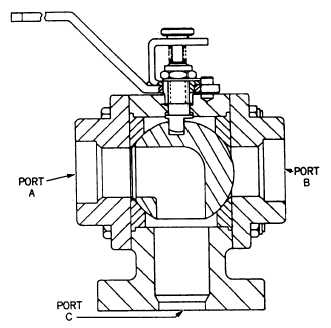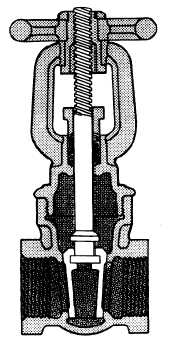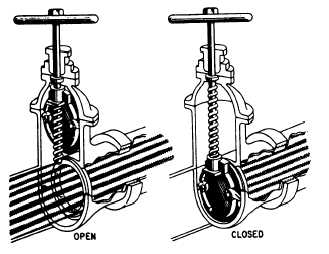Figure 6-3.—Three-way ball valve.
GATE VALVES
Gate valves are used when a straight-line flow
of fluid and minimum flow restriction are needed.
Gate valves are so-named because the part that
either stops or allows flow through the valve
acts somewhat like a gate. The gate is usually
wedge-shaped. When the valve is wide open the
gate is fully drawn up into the valve bonnet. This
leaves an opening for flow through the valve the
same size as the pipe in which the valve is installed
(fig. 6-4). Therefore, there is little pressure drop
or flow restriction through the valve.
Gate valves are not suitable for throttling
purposes. The control of flow is difficult because
of the valve’s design, and the flow of fluid
slapping against a partially open gate can
cause extensive damage to the valve. Except as
specifically authorized, gate valves should not be
used for throttling.
Gate valves are classified as either rising-stem
or nonrising-stem valves. The nonrising-stem
valve is shown in figure 6-4. The stem is threaded
into the gate. As the handwheel on the stem is
rotated, the gate travels up or down the stem on
the threads while the stem remains vertically
stationary. This type of valve will almost always
have a pointer indicator threaded onto the upper
end of the stem to indicate the position of the gate.
Valves with rising stems (fig. 6-5) are used
when it is important to know by immediate
inspection whether the valve is open or closed and
when the threads (stem and gate) exposed to the
fluid could become damaged by fluid contami-
nants. In this valve, the stem rises out of the valve
when the valve is opened.
GLOBE VALVES
Globe valves are probably the most common
valves in existence. The globe valve gets its name
Figure 6-4.—Operation of a gate valve.
6-3
Figure 6-5.—Rising stem gate valve.






